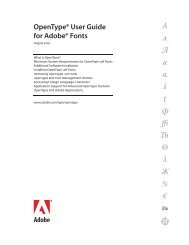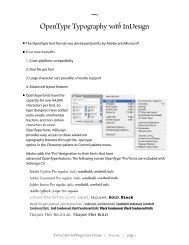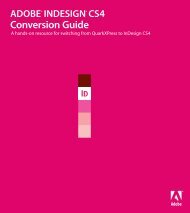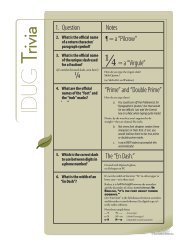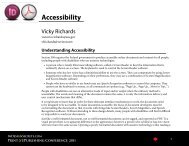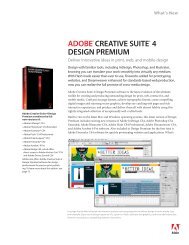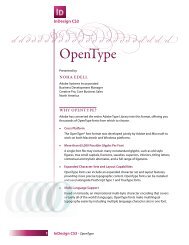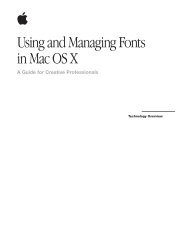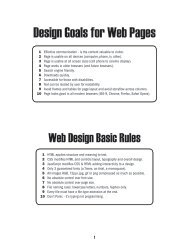Quark to InDesignCS3 Conversion Guide - InDesign User Group
Quark to InDesignCS3 Conversion Guide - InDesign User Group
Quark to InDesignCS3 Conversion Guide - InDesign User Group
Create successful ePaper yourself
Turn your PDF publications into a flip-book with our unique Google optimized e-Paper software.
Understanding Master Pages<br />
A B C D E<br />
A. master<br />
B. Document page with master applied<br />
C. Changes <strong>to</strong> document page<br />
D. Update <strong>to</strong> master (orange frame)<br />
E. Document with changes and master<br />
update<br />
master pages; in <strong>InDesign</strong>, you use<br />
the Pages panel (Window > Pages).<br />
You can do a few things with<br />
<strong>InDesign</strong> master pages that you<br />
can’t do with <strong>Quark</strong>XPress, such as:<br />
• Base master pages on other master<br />
pages. For example, if you’re<br />
creating a publication that uses<br />
both a two-column layout and a<br />
three-column layout, and the layouts<br />
are identical except for the<br />
number of columns, you can base<br />
the three-column master on the<br />
two-column master. All changes<br />
you make <strong>to</strong> the “parent” master<br />
are au<strong>to</strong>matically applied <strong>to</strong> the<br />
“child” master.<br />
• Apply a master page <strong>to</strong> multiple<br />
document pages in one step.<br />
• Save a document page as a<br />
master page.<br />
• Select—and, optionally, delete—<br />
unused master pages.<br />
• Override master page settings<br />
or detach objects on document<br />
pages from their master pages.<br />
• Drag and drop master pages<br />
between documents.<br />
• Synchronize master pages across<br />
multiple documents or all documents<br />
in a book.<br />
Master objects on document pages<br />
behave differently in <strong>Quark</strong>XPress<br />
than in <strong>InDesign</strong>. In <strong>Quark</strong>XPress,<br />
you select master objects on document<br />
pages just as you select other<br />
(non-master) objects—by clicking<br />
them with the Item or Content<br />
<strong>to</strong>ol. In <strong>InDesign</strong>, master objects<br />
on document pages are protected<br />
so that a user cannot accidentally<br />
modify, move, or delete them. To<br />
override the protection and select<br />
a master object on a document<br />
page, select the Selection, Direct<br />
Selection, or Position <strong>to</strong>ol, and then<br />
press Shift+Command in Mac OS<br />
or Shift+Ctrl in Windows, and click<br />
the object. To prevent a master<br />
object from being selected on a<br />
document page, select the object<br />
on the master page, and then deselect<br />
Allow Master Item Overrides<br />
On Selection in the Pages panel<br />
menu. On document pages, the<br />
object is displayed without a frame<br />
edge. If you select Allow Master<br />
Item Overrides for an object on<br />
a master page, the object is displayed<br />
with a dotted line around<br />
its edge on document pages.<br />
If you modify a master object on<br />
a document page, for example,<br />
by changing its fill color, and you<br />
then modify the master object, all<br />
modifications you make <strong>to</strong> the master<br />
object except applying a new<br />
fill color are applied <strong>to</strong> the master<br />
object on the document page.<br />
Setting Up Documents, Pages, and Master Pages 23







